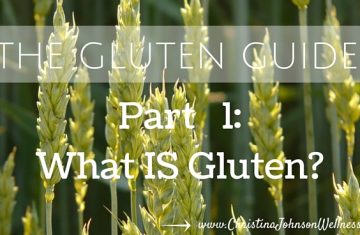After learning what gluten is and what gluten does to your body in parts one and two of The Gluten Guide, you may now be wondering if you personally are being negatively impacted by gluten. You may have even asked yourself the question, should I go gluten free?
Before assuming that you aren’t sensitive to the effects of gluten, keep an open mind to this possibility as you read through this article. Many people have absolutely no idea how gluten is truly impacting their health until they try one of the methods mentioned here to figure it out. In fact, JJ Virgin estimates that as many as 90% of her clients feel better after removing gluten…that’s a lot of people [1]!
Determining whether or not you should go gluten free can be approached from a few different ways. But first, it is helpful to know that all people fall onto a spectrum when it comes to gluten related issues. Let’s try to figure out where you are on the spectrum!
Three Possible Reactions to Gluten
Chris Kresser describes how reactions to gluten fall onto a spectrum of conditions [2]. Here are 3 possible reactions to gluten that are on different points of this spectrum:
- Celiac Disease: This is the most severe type of reaction to gluten and lies on the far end of the spectrum. It is an autoimmune disease that can affect almost all other tissues and systems in the body, such as the brain, liver, blood vessels, and stomach.
- Non-Celiac Gluten Sensitivity: This condition falls somewhere in the middle of the spectrum. One way to define gluten sensitivity is “a reaction to gluten that resolves when gluten is removed from the diet and after celiac disease and a gluten allergy have been ruled out” [2]. This reaction is usually less severe than full blown celiac disease.
- Tolerance: Finally, we have the other far end of the spectrum. People here appear to be able to maintain excellent health while eating gluten. It is difficult for researchers to explain why gluten can cause such extensive damage to some people’s health while seeming to not affect other people at all, but many factors are most likely at play.
It is important to keep in mind that it is quite possible for someone to shift from tolerance to gluten sensitivity or even to celiac disease over time. Unfortunately, scientists are still trying to better understand what events can trigger someone to go from tolerating gluten to no longer tolerating it [2].
Signs of Gluten Intolerance
So how do you know if gluten may be bothering you or if you are one of the lucky few who fall into the “tolerance” category? The signs and symptoms of gluten sensitivity and celiac disease can be very broad and far reaching, but here are some common symptoms:
- Weight gain or inability to lose weight
- Food cravings
- Digestive issues (gas, bloating, diarrhea, constipation)
- Headaches
- Joint pain
- Anxiety
- Depression
- Brain fog
- Leaky gut
- Fatigue or feeling tired after eating a meal with gluten
- Diagnosis of an autoimmune disease
- Hormone imbalance or unexplained infertility
- ADHD
- Low immunity (you get sick often)
- Canker sores
- Migraine headaches
- Skin problems (eczema, acne, psoriasis, rashes, etc)
I could continue, but I think you get the point!
The frustrating part is that factors other than gluten could be causing some of these issues for you. However, we know for sure that these symptoms have been linked to gluten sensitivity or celiac disease for many people.
How Do You Determine if Gluten Is Harming Your Body?
So if you have some of the symptoms mentioned above, how can you figure out if they are being caused by gluten?
The following two methods can be used to determine if you are sensitive to gluten or if you have celiac disease: lab testing and the elimination & reintroduction challenge.
Lab Testing
Lab testing for celiac disease or gluten sensitivity is possible with a simple blood test; however, many limitations exist to this type of test.
Gluten is comprised of hundreds of components and sub-fractions, so the problem with conventional lab testing is that it usually only screens for a reaction to two of the many components of the wheat protein. As a result, many people come up negative for these two components and are then told that they do not have celiac disease or a gluten sensitivity [3].
Unfortunately, these individuals could still be reacting to one of the many other components in gluten. The false negative they can be given, though, leads them to think they can eat gluten without any problems, which may very well not be the case.
So if you choose to have lab testing done, be sure that your doctor orders a thorough lab test that checks for more than just two of the components in gluten.
Elimination & Reintroduction
Since lab testing can be expensive and does not always yield accurate results, most experts agree that the best method to determine if gluten is negatively impacting your health is to do an elimination and reintroduction challenge.
What is an elimination and reintroduction challenge? To complete this challenge you would completely avoid all forms of gluten for at least 30 days. After the 30 days are up, you then slowly reintroduce gluten to see if or how it impacts your body.
Here are a few facts to keep in mind if you are considering doing this type of challenge:
- Gluten is a large protein, and its effects on your body can be long lasting. As a matter of fact, eating gluten one time can impact your body for up to 3 months [4]! So avoiding gluten for a minimum of 30 days is crucial in order to allow the gluten you have been previously eating to leave your system.
- Even a small amount of gluten (think about a tiny bread crumb in the butter dish) can cause harm to some people who are truly sensitive to gluten. As a result, if you want this challenge to be as accurate as possible, you must avoid ALL sources of gluten…100% of the time for the 30 days.
- This last point may be difficult for many of you, but because gluten and the protein found in dairy (casein) are structurally similar, your body can have a difficult time distinguishing between the two. Therefore, people who are sensitive to gluten are often also sensitive to dairy. So for this challenge to be as effective and informative as possible for you, it is wise to consider eliminating both gluten and dairy for these 30 days [5].
Before you think this challenge is completely impossible or overwhelming for you, please know that I understand your hesitations and concerns. I have personally done this challenge, and I know how difficult it can be. I’m not going to lie to you about that!
But, I can also tell you from the other side of the challenge how rewarding it truly is to understand how good I can feel without certain foods in my diet. If you think you would need extra support to do this challenge, keep reading below to find out how I might be able to help support you.
Give the Challenge a Try!
If you can relate to any of the symptoms of gluten sensitivity that I listed at the beginning of the article, and if you would LOVE to start feeling better, then there is no harm in trying this challenge for 30 days.
You can always go back to eating gluten and dairy at the end of the challenge, but you will be doing so armed with the knowledge of exactly how these foods are impacting your body. And knowledge truly is power!
So, if you’re up for the challenge, here are the steps of the challenge listed out:
- Eliminate 100% of the gluten and dairy from your diet for a minimum of 30 days.
- Be sure to look carefully for hidden sources of gluten or dairy in all of the processed food you eat, the food you eat in restaurants, and food that other people make for you.
- Take note of any symptoms you are experiencing before beginning the challenge, and pay close attention to your body throughout the challenge. Are any symptoms improving or being eliminated for you?
- At the end of the 30 days, take note of how you feel overall. Do you feel generally healthier? Fewer headaches, joint pain, mood swings, skin issues? Better sleep, clearer thinking, etc? Or has nothing changed for you? If you feel better, chances are really good that gluten and/or dairy was harming your health.
- If you would like to be certain, you can add in one gluten containing food item to one of your meals. The next day, try it again in a small dose. Observe your body over the next 3 days to see if any of your old symptoms begin to pop back up.
- If you notice old symptoms reappearing, then you are probably sensitive to gluten and should consider avoiding it.
- After a week or so of reintroducing gluten, then attempt to reintroduce dairy and observe its effects on your body.
- Once again, if you notice old symptoms reappearing as you introduce dairy, then you are probably sensitive to it and should consider avoiding it.
Don’t Want to Do the Challenge On Your Own?
For those of you would love to participate in this challenge so that you can increase your energy and start feeling better, but you feel overwhelmed by the idea of giving up gluten and dairy for 30 days, then I would love to help you!
Armed with support, guidance, and accountability, this journey can be much more manageable (and even enjoyable!) for you. I would like to offer you a 30 minute discovery session where I will ask you questions to help you get clarity on exactly how you would like to improve your health, and then I will offer a recommendation for you on what next step (such as the elimination and reintroduction challenge) might be most useful for you. If you’re interested, we can also explore how I might be able to help you through the process.
Simply click here to apply for a complimentary Discovery Session. I would love to learn more about you and help you start achieving all of your health goals!
YOU Know Your Body Best
Trust me when I say that you know your body best! Not your doctor, your lab work, or anything else. If you eliminate gluten and dairy for 30 days and feel better, then you can feel confident that you are sensitive to these proteins. You truly don’t need any “expert” to confirm that for you.
I believe that it can be so empowering to understand the impact of food on your body, and this approach of an elimination and reintroduction challenge truly is the best way to determine whether or not gluten is impacting you.
Then and only then will you be able to confidently answer the question: should I go gluten free?
If you happen to decide that going gluten free is the right decision for you, then the last part of The Gluten Guide will give you my top tips for how to go gluten free for good.
In the meantime, please let me know in the comments if you are considering the elimination and reintroduction challenge. I would love to hear what you discover about your body through this challenge!
Sources
[1] Virgin, JJ. (November 2014). JJ Virgin’s Sugar Impact Diet. New York, NY: Hachette Book Group.
[2] Kresser, Chris. (2013). The Paleo Cure. New York, NY: Little, Brown and Company.
[3] Kresser, Chris. (April 2013). 50 Shades of Gluten (Intolerance). Retrieved from http://chriskresser.com/50-shades-of-gluten-intolerance/.
[4] Meyers, Amy. (September 2015). 3 Important Reasons to Give Up Gluten If You Have an Autoimmune Disease. Retrieved from http://www.amymyersmd.com/2015/09/3-important-reasons-to-give-up-gluten-if-you-have-an-autoimmune-disease/.
[5] Wahls, Terry. (2014). The Wahls Protocol: How I Beat Progressive MS Using Paleo Principles and Functional Medicine. New York, NY: Penguin Group.



